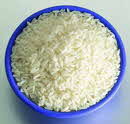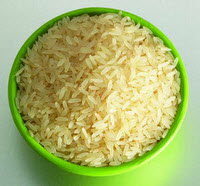Home | FOOD ARTICLES | Food Trivia | Today_in_Food_History | Food_History_Timeline | Recipes | Cooking_Tips | Food_Videos | Food_Quotes | Who’s_Who | Culinary_Schools_&_Tours | Food_Trivia_Quizzes | Food_Poems | Free_Magazines | Food_Festivals_and_Events
Food Articles, News & Features Section
FREE Magazines
and other Publications
Free Professional and Technical Research, White Papers, Case Studies, Magazines, and eBooks
Rice Varieties, Types and Forms
Worldwide there are more than 40,000 different varieties of rice, though only a small number offer the quality acceptable to be grown commercially in the U.S. In the United States. Rice types can be divided into long, medium, and short grain. Limited waxy rice and arborio is produced, as well as some aromatic and specialty varieties.
The primary differences in these rices is their cooking characteristics and, in some cases, a subtle flavor difference. From a nutritional standpoint they are equal and indeed can often (with the exception of waxy rice or arborio) be interchanged in recipes.
See also: Rice: Rinse or Soak?; Brown Rice; Rice History;
Rice Recipes; Rice Cooking Tips; Rice Trivia
MAJOR RICE VARIETIES
and UNITED STATES RICE TYPES
LONG GRAIN RICE
Long grain rice has a long, slender kernel, four to five times longer than its width. Cooked grains are separate, light and fluffy.
MEDIUM GRAIN RICE
Medium grain rice has a shorter, wider kernel (two to three times longer than its width) than long grain rice. Cooked grains are more moist and tender, and have a greater tendency to cling together than long grain.
SHORT GRAIN RICE
Short grain rice has a short, plump, almost round kernel. Cooked grains are soft and cling together.
SWEET OR WAXY RICE
U.S. sweet rice is short and plump with a chalky white, opaque kernel. When cooked, sweet rice loses its shape and is very glutinous. Sweet is more often used in commercial product formulations. The starch and flour from sweet rice is used in frozen products as a binder for gravies, sauces, and fillings because it is resistant to breakdown during freezing and thawing, unlike some corn or wheat starches.
AROMATIC RICE VARIETIES
AROMATIC RICES have a flavor and aroma similar to that of roasted nuts or popcorn. The natural compound that gives aromatic rice the characteristic aroma and flavor is present in all rice, but in the aromatic varieties it is present in much higher concentrations. The most popular domestically grown aromatic rices include: della which cooks dry, separate and fluffy; jasmine which cooks more moist and tends to cling together; and basmati which cooks into very long, slender grains which are dry, separate and fluffy.
U.S. AROMATIC red rice has a deep, honey-red bran. Like brown rice, it is minimally processed to retain its bran layers and takes 45 to 50 minutes to prepare. Cooked grains have a savory, nutty flavor and are slightly chewy.
BASMATI RICE: a long grain fragrant rice, aged to enhance aroma and reduce moisture content. Grown in India and Pakistan.
U.S. BASMATI RICE is an aromatic long grain rice that has a distinctive aroma and flavor similar to that of popcorn or roasted nuts. When cooked, it swells only lengthwise, resulting in long slender grains that are dry, separate and fluffy.
TEXMATI is a cross between basmati rice and American long grain rice.
BLACK RICE is a black whole grain, aromatic rice usually used in desserts. Varieties include Chinese Forbidden Blak and Thai Black Sticky Rice.
U.S. BLACK JAPONICA is an aromatic rice with a dark black bran. Like brown rice, it is minimally processed to retain its bran layers and takes 45 to 50 minutes to prepare. Cooked grains are slightly chewy with a subtle sweet spiciness.
CALROSE (California Rose) a medium grain rice originally developed in California for ease of mechanical harvesting and minimal water use. Numerious varieties developed from the original are the most popular rice in U.S.
U.S. DELLA, DELROSE, and DELMONT varieties combine the qualities of regular long grain rice and basmati rice. They have an aroma similar to basmati. However, cooked grains swell in both length and width, like regular long grain rice.
JASMINE RICE is a long grain Thai rice with a unique aroma.
U.S. JASMINE RICE is an aromatic long grain rice that has a distinctive aroma and flavor similar to that of popcorn or roasted nuts. Cooked grains are soft, moist and cling together.
RED RICE - a fragrant reddish brown whole grain rice grown in Bhutan, France and other areas.
WEHANI RICE is an aromatic long grain reddish-brown rice developed from basmati rice by Lundbeerg Family Farms.
ARBORIO RICE
Arborio rice is an Italian short grain rice with high starch content, traditionally used to make Risotto.
U.S. Arborio rice is a large, bold rice with a characteristic white dot at the center of the grain. By the way of length/width ratio and starch characteristics, it is classified as a medium grain rice. Primarily used in risotto, this rice develops a creamy texture around a chewy center and has exceptional ability to absorb flavors.
Carnaroli Rice is in the same family as Arborio rice but with a larger grain. From Piedmont and Lombardy regions of Italy, it is considered to be one of the best rices for Risotto.
RICE FORMS

ROUGH (PADDY OR CARGO) RICE:
Kernels still within the hull. Before the rice can be packaged or cooked, the outer hull or husk must be removed.

BROWN RICE
Kernels of rice from which only the hull has been removed. Brown rice may be eaten as is or milled into white rice. Cooked brown rice has a slightly chewy texture and a nut-like flavor. The light brown color of brown rice is caused by the presence of bran layers which are rich in minerals and vitamins, especially the B-complex group.

REGULAR MILLED WHITE RICE:
Regular-milled white rice, often referred to as “white” or “polished” rice is the most common form of rice. The outer husk is removed, and the layers of bran are milled until the grain is white.

PARBOILED RICE:
Rough rice that has gone through a steam-pressure process before milling. This procedure gelatinizes the starch in the grain, and ensures a firmer, more separate grain. Parboiled rice is favored by consumers and chefs who desire an extra fluffy and separate cooked rice.
PRECOOKING RICE
White or brown rice that has been completely cooked and dehydrated after milling. This process reduces time required for cooking.
USA Rice Federation www.usarice.com
RELATED ARTICLES
Please feel free to link to any pages of FoodReference.com from your website.
For permission to use any of this content please E-mail: james@foodreference.com
All contents are copyright © 1990 - 2025 James T. Ehler and www.FoodReference.com unless otherwise noted. All rights reserved.
You may copy and use portions of this website for non-commercial, personal use only.
Any other use of these materials without prior written authorization is not very nice and violates the copyright.
Please take the time to request permission.

